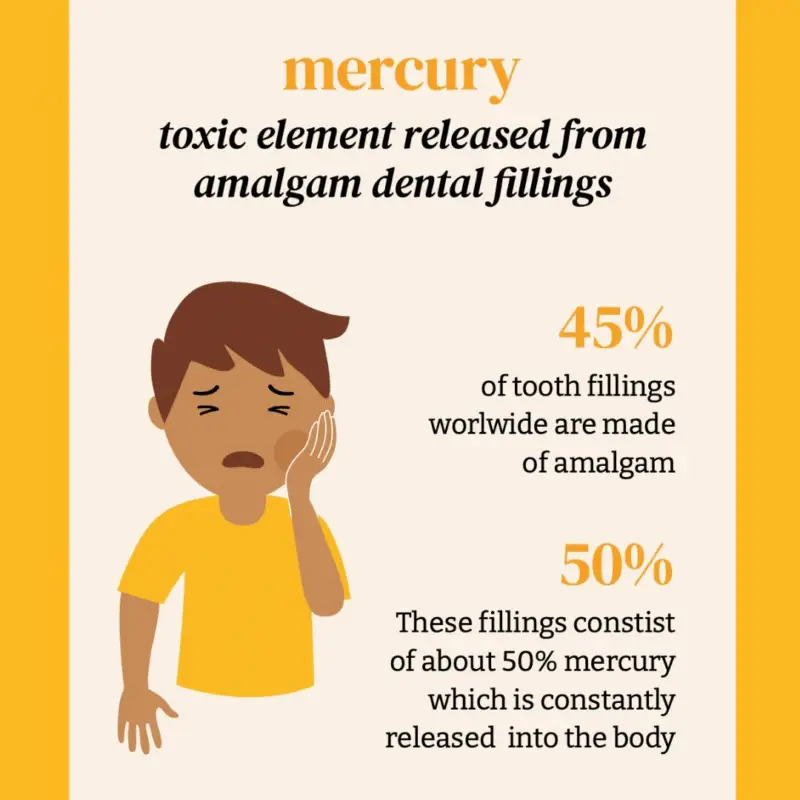
Amalgam fillings are considered bad for health because they release small amounts of elemental mercury vapor, a neurotoxin that can be inhaled and absorbed by the body. While health and dental agencies have stated this is not a significant risk for the general population, a growing body of evidence suggests cumulative exposure may harm vulnerable groups and cause side effects in some individuals. [1, 2]
How mercury is released and absorbed • Dental amalgam fillings are made of about 50% elemental mercury, along with a powdered alloy of metals like silver, tin, and copper.
- Small amounts of mercury vapor can be released from these fillings during chewing, brushing, and grinding of teeth. Drinking hot liquids may also increase the release of this vapor.
- When released, the mercury vapor is inhaled and absorbed by the lungs, allowing it to circulate in the bloodstream. Some of this mercury can accumulate over time in the body’s organs, including the brain and kidneys. [1, 3, 4, 5]
Health concerns associated with mercury vapor Potential adverse health effects associated with long-term, low-level mercury exposure from dental amalgam include:
- Neurological damage: As a neurotoxin, mercury can affect the central nervous system. Exposure has been linked to mood changes, anxiety, depression, memory loss, fatigue, tremors, and sleep disturbances.
- Kidney impairment: Mercury can accumulate in the kidneys and has been linked to kidney function issues in people with dental amalgam.
- Autoimmune issues: Chronic, low-dose mercury exposure is considered a possible trigger for certain autoimmune diseases like multiple sclerosis and systemic lupus erythematosus in susceptible individuals.
- Allergic reactions: In rare cases, some people may have allergic or hypersensitivity reactions to mercury or other metals in amalgam, causing oral lesions or other skin irritations. [1, 6, 7, 8, 9, 10]
Individuals at higher risk While regulatory bodies like the FDA state that amalgam is safe for most people, they have identified certain vulnerable populations who may be at greater risk:
- Pregnant or nursing women: Mercury can pass through the placenta and be transferred via breast milk, potentially impacting a developing fetus or infant’s neurological system.
- Children, especially under age six: A child’s developing neurological system may be particularly sensitive to mercury’s neurotoxic effects.
- People with pre-existing neurological conditions: Individuals with conditions like multiple sclerosis, Alzheimer’s, or Parkinson’s may be at higher risk of adverse effects from mercury exposure.
- People with kidney dysfunction: Impaired kidney function can reduce the body’s ability to excrete mercury, leading to higher accumulation.
- People with mercury sensitivity or allergies: Those with a known allergy to mercury should avoid amalgam fillings. [2, 10, 11, 12, 13]
Alternatives to amalgam Due to the health and environmental concerns associated with mercury, the use of amalgam fillings has declined. Common alternatives include:
- Composite resin: Tooth-colored fillings made from ceramic and plastic compounds.
- Porcelain: A durable, stain-resistant material.
- Gold: A very durable and long-lasting option. [14, 15, 16, 17, 18]
If you are concerned about your current amalgam fillings, it is important to discuss the risks and benefits of removal with a dentist. Removing intact fillings can cause a temporary spike in mercury vapor exposure and is generally only recommended when medically necessary. [5]
AI responses may include mistakes.
[1] https://www.fda.gov/medical-devices/dental-devices/dental-amalgam-fillings[2] https://www.fda.gov/news-events/press-announcements/fda-issues-recommendations-certain-high-risk-groups-regarding-mercury-containing-dental-amalgam[3] https://www.smilesbyshields.com/how-can-mercury-fillings-damage-your-body-and-the-environment/[4] https://www.fda.gov/medical-devices/dental-devices/dental-amalgam-fillings[5] https://www.fda.gov/medical-devices/dental-amalgam-fillings/information-patients-about-dental-amalgam-fillings[6] https://pmc.ncbi.nlm.nih.gov/articles/PMC3025977/[7] https://sfgreendentist.com/the-dangers-of-mercury-fillings/[8] https://gardeniadentistry.com/mercury-fillings-dangers/[9] https://www.fda.gov/medical-devices/dental-amalgam-fillings/information-patients-about-dental-amalgam-fillings[10] https://www.fda.gov/medical-devices/dental-amalgam-fillings/information-patients-about-dental-amalgam-fillings[11] https://iaomt.org/resources/dental-mercury-facts/amalgam-fillings-danger-human-health/[12] https://gorbatovdentistry.com/press-center/dangers-toxicity-mercury/[13] https://pmc.ncbi.nlm.nih.gov/articles/PMC3905169/[14] https://www.roswellpark.org/cancertalk/202412/can-mercury-dental-fillings-cause-cancer[15] https://makeo.app/blog/oral-care/adverse-effects-of-dental-amalgam-fillings[16] https://www.roswellpark.org/cancertalk/202412/can-mercury-dental-fillings-cause-cancer[17] https://www.rrdentistry.com/blog/why-are-mercury-fillings-considered-unsafe/[18] https://www.nwnaturaldentistry.com/mercury-free-dentistry-what-you-need-to-know/

